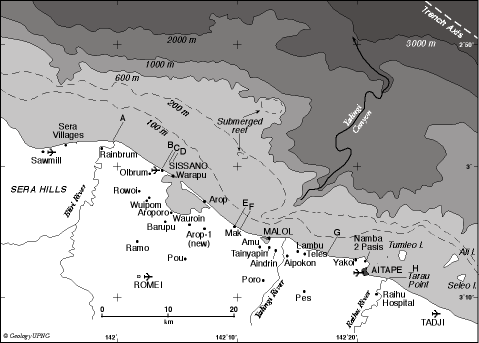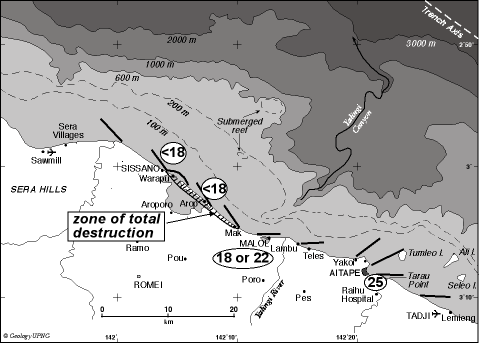 Arthur Capell, writing nearly half a century ago, but only 20 years after the creation of proto-Austronesian, by Otto Dempwolff, gives some idea of just exactly how 'proto-Austronesian' came about:
Arthur Capell, writing nearly half a century ago, but only 20 years after the creation of proto-Austronesian, by Otto Dempwolff, gives some idea of just exactly how 'proto-Austronesian' came about:Dempwolff (1938) established a vocabulary of some 2,000 words which he regarded as "Original Austronesian" (Uraustronesisch).
- The basis of this restoration is found in [just] two Western IN (Indonesian) languages, Toba-Batak (Sumatra) and Javanese, and one Northern IN language, Tagalog (Philippines).
These, with occasional references to Malagasy, Ngadju (Borneo), and a few other languages, served to establish proto-IN (Indonesian).
- He later added to his list Fijian and Sa'a (Southeast Solomons) and based a "proto-MN (Melanesian)" on the agreements of these with his IN (Indonesian).
- In the third stage, he examined three PN (Polynesian) languages (Tongan, eastern Futuna, and Samoa) and similarly established a proto-PN (Polynesian). In each of the latter two cases he sought to establish phonological innovations on the *AN sound-system, to determine what vocabulary appeared in each of the MN (Melanesian) and PN (Polynesian) areas, again with scant attention to MC (Micronesian).
- Moreover, all his PN (Polynesian) languages belong to the western subgroup of the family, without reference to Tahitian or Maori of the eastern subfamily. He did not seek to establish any original AN (Austronesian) morphology; and very little has yet been done in that sphere.
Arthur Capell - Oceanic Linguistics Today - Current Anthropology, Vol. 3, No. 4. (Oct., 1962), pp. 371-428.
http://links.jstor.org/sici?sici=0011-3204%28196210%293%3A4%3C371%3AOLT%3E2.0.CO%3B2-2
Andrew Pawley and Malcom Ross carry on the story:
During the 1960s and 1970s a more complex theory of AN high order subgroups emerged from work on historical phonology and morphology. The poorly documented Formosan languages, completely left out of Dempwolff's comparisons, became key witnesses in the reconstruction of PAN. Several changes to Dempwolff's proposed PAN sound system have been made in the light of Formosan testimony .
Dyen noted the possibility of a primary split in AN between
(a) some or all Formosan languages and
(b) a group containing all other AN languages on the grounds of phonological mergers common to all the extra-Formosan languages.
Dahl argued forcefully for such a primary split.
Blust named the extra-Formosan branch "Malayo-Polynesian" (MP) and gave a morphological argument supporting it. Although several scholars have expressed strong reservations (Wolff, Dyen),the hypothesis has gained increasing acceptance.
...According to Blust, Harvey, and Reid the Formosan languages may comprise more than one first-order branch of AN, perhaps dividing into Atayalic (northern), Tsouic (central), and Paiwanic (southern) groups.
... Although most Philippine languages seem at least superficially similar to each other, Reid suggests that they have no significant innovations in common. Zorc challenges Reid, arguing that Philippine languages share numerous lexical replacements and that these constitute innovations defining a Philippine subgroup. The problem in the Philippines, as in many other compact regions, is to distinguish innovations from borrowings among related languages that have been in contact for millennia. A recent study of Tiruray (Mindanao) vocabulary shows that this Philippine language has replaced nearly 30% of its basic vocabulary with loans from its neighbors.
Blust has proposed a more detailed family tree. In this tree the
Western MP comprises chiefly the languages of the Philippines, Malaysia, western Indonesia (including Sulawesi) as far east as mid-Sumbawa, and Madagascar and
Central MP comprises approximately the languages of eastern Indonesia east of Sumbawa and Sulawesi excluding Halmahera.
Oceanic remains, but it has been demoted to something like a fourth-order subgroup.[;-(]
...It is probably fair to say that of Blust's proposed subgroups, MP and three of its daughters-Eastern MP, South Halmahera/West New Guinea, and Oceanic-are rather widely accepted because each is based on a significant body of diagnostic innovations. Western MP, Central MP, and Central~Eastern M P, on the other hand, are much more problematic. The difficulties in finding innovations encompassing the entire putative Central MP group very likely reflect the existence of an earlier extensive and longstanding dialect network in the eastern Indonesian region . What one finds is overlapping innovations, each covering part of the region. As 'a whole, Western MP languages seem to inherit only the innovations shared by all MP languages, i.e. those attributable to Proto MP (PMP).
This suggests that there was no Proto Western MP, but rather that PMP diverged into a number of dialects, one of whose descendants became Proto Central Eastern MP. The Western MP languages are simply those MP languages that do not belong to the Central Eastern group. In the same vein, Central MP languages may be just those Central Eastern languages that are not members of Eastern MP.
However, Pawley and Ross do not even mention that Isidore Dyen, a giant in Austronesian language studies, still believes that the Austronesian languages originated around Melanesia, and merely relegate him to a bit-part in the formation of the Out-of-Taiwan paradigm.
Some Evidence Favoring the Central Hypothesis. Isidore Dyen. Yale University (Emeritus).
www.sil.org/asia/philippines/ical/papers/dyen-evidence_central_hypothesis.pdf
The Out-of-Taiwan paradigm rests on remarkably little:
The Malayo-Polynesian (MP) hypothesis (that all extra-Formosan languages belong to a single first-order An subgroup, while the Formosan languages constitute one or more first-order subgroups) rests on the following phonological (and some nonphonological) innovations:
(a) PAn *C and *t merged as PMP *t.
(b) PAn noninitial *L and *n merged as PMP *n.
(c) PAn *S became a glottal spirant in PMP, possibly merging with *h.
The Sound of Proto-Austronesian: An Outsider's View of the Formosan Evidence
Malcolm D. Ross Oceanic Linguistics, Vol. 31, No. 1. (Summer, 1992), pp. 23-64.
http://links.jstor.org/sici?sici=0029-8115%28199222%2931%3A1%3C23%3ATSOPAO%3E2.0.CO%3B2-V
But then Robert Blust, by now the leader of the pack, produced his bombshell:
Blust, R. (1999). "Subgrouping, circularity and extinction: some issues in Austronesian comparative linguistics" in E. Zeitoun & P.J.K Li (Ed.) 'Selected papers from the Eighth International Conference on Austronesian Linguistics' (pp. 31-94). Taipei: Academia Sinica.
showing not only that Formosan languages differed radically from all others in the Austronesian family, but they formed no less than nine separate first-order families, each ranking equal with Proto-Malayo-Polynesian.
This was soon followed by a blitz of publicity:
Taiwan’s gift to the world - Jared M. Diamond
 Quote: "A reanalysis of Austronesian languages by Robert Blust strengthens the identification of the first Austronesian waystation, illuminates archaeological findings and the history of boatbuilding, and may help reinterpret the histories of other language families".
Quote: "A reanalysis of Austronesian languages by Robert Blust strengthens the identification of the first Austronesian waystation, illuminates archaeological findings and the history of boatbuilding, and may help reinterpret the histories of other language families".- In fact, of the 94 pages of Blust's 1999 paper:
- Only 14 deal with the language classification (within Formosa alone, not of Austronesian languages in general, and concerning phonology only), with some notes about coastal/inland Formosan vocabularies.
- 13 pages are devoted to dismissing competing theories
- 4+ deal with the putative Austronesian Mainland Homeland, (and the embarrassing question of why there's no trace of them). There's also the embarrassing question of why, if the speakers of proto-Malayo Polynesian left Taiwan, they also left no traces behind them.
- 9 deal with boats (although he has some difficulty in proposing a viable method of boat transport from Taiwan out to the Philippines that would be sufficient to set in train a major wave of emigration).
Entrenchment of the Myth:
When a multidisciplinary conference was held in Geneva in June 2004, Peter Bellwood felt able to say, with full confidence:
"As a linguistic category, the Austronesian languages have a history of dispersal from Taiwan through the Philippines into Island Southeast Asia and on to Oceania and Madagascar.
Malcolm Ross explained why the majority of linguists accept Taiwan as the Proto-Austronesian homeland and in what directions the ancestral languages spread and emphasized their transmission through inheritance rather than language shift, implying that the Austronesian language dispersal was associated with an actual movement of Austronesian-speaking people....
Bellwood, Peter & Alicia Sanchez-Mazas (June 2005). "Human Migrations in Continental East Asia and Taiwan: Genetic, Linguistic, and Archaeological Evidence". Current Anthropology 46:3: 480-485
So, it's definite, isn't it?
Well, this little map may be a clue to the 'political' (in the very widest sense) motivation of the Blust-Diamond-Bellwood-everyone else bandwagon, who (mostly) believe the Chinese kicked the Austronesians into Taiwan, and then nudged them gently out to Easter Island and Madagascar: There may be a hint of the strong current political and nationalist motivation behind the Out-of-Taiwan hypothesis in the accompanying article
There may be a hint of the strong current political and nationalist motivation behind the Out-of-Taiwan hypothesis in the accompanying article
Indeed, one wonders whether Taiwan would figure in the Austronesian story at all from the 1950s onwards if Chiang Kai-Shek hadn't retreated there in 1949, and opened up the place to his American allies, and if a 'native' Taiwanese (Li Denghui) hadn't become president of Taiwan in 1990, with an implicit agenda of promoting Taiwanese separation from China.















